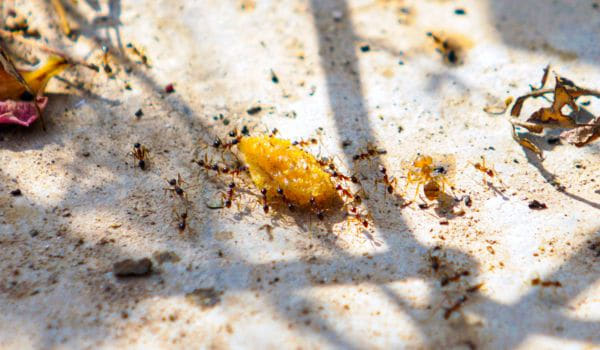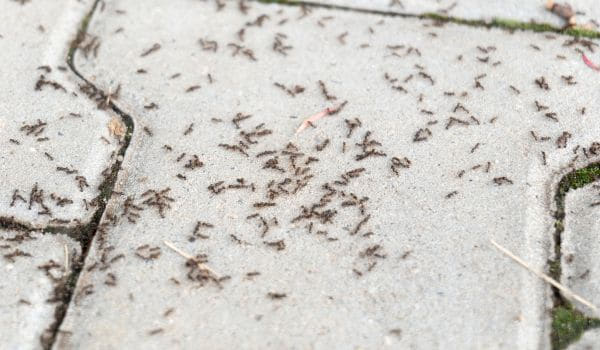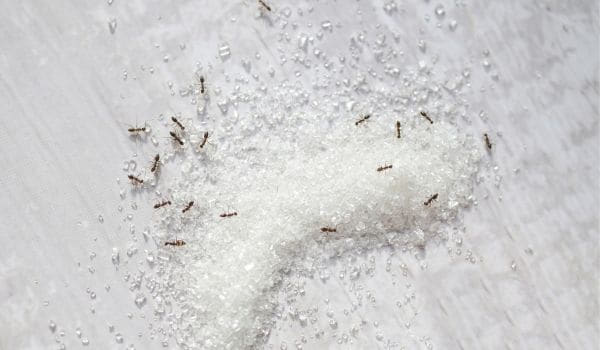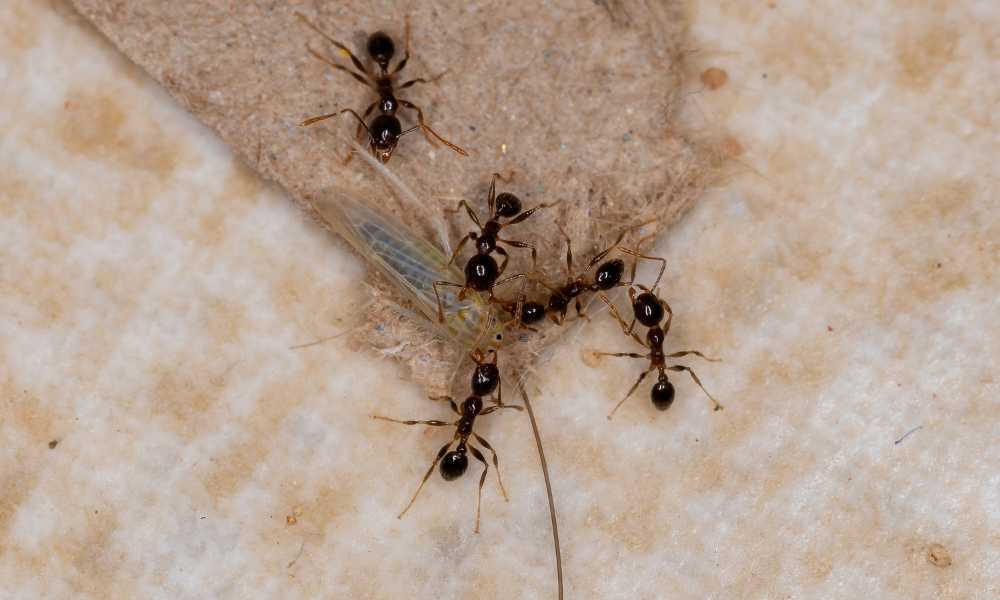In the battle against household pests, tiny black ants in the kitchen can pose a persistent and irritating challenge for homeowners. These minuscule invaders, often attracted by food and water sources, can quickly establish colonies, leading to unsightly trails across countertops and pantry shelves. While individually harmless, their collective presence can become a nuisance and compromise the hygiene of the kitchen space. Addressing this issue promptly is crucial not only for the sake of cleanliness but also to prevent potential food contamination and damage. In this guide, we will explore effective strategies to eliminate these unwelcome guests and safeguard your kitchen from future ant infestations.
Identification of Tiny Black Ants

Physical characteristics
Tiny black ants, scientifically known as Monomorium minimum, are characterized by their small size, typically ranging from 1 to 2 millimeters in length. They have a shiny black exoskeleton, segmented bodies, and elbowed antennae. These ants are distinguishable by their diminutive size and uniform dark coloration.
Behavior and nesting habits
Tiny black ants are social insects that live in colonies, often nesting in hidden or protected areas. They display organized foraging patterns, following trails to and from their nests. These ants are particularly adept at exploiting food resources and establishing satellite colonies near potential food sources. Understanding their behavior and nesting habits is crucial for effective eradication strategies.
Common Causes of Ant Infestations

Food sources
One of the primary reasons for ant infestations in the kitchen is the availability of food. Tiny black ants are attracted to sugary, greasy, and protein-rich substances commonly found in kitchens. Crumbs, spills, and improperly stored food can serve as enticing food sources, leading to increased ant activity.
Water sources
Ants require water to survive, and kitchens with persistent moisture or water leaks can attract them. Accumulated condensation, leaky pipes, or wet areas around sinks create favorable conditions for ant infestations. Eliminating water sources is vital for comprehensive ant control.
Entry points
Ants can infiltrate homes through various entry points, such as cracks, gaps, or openings around windows and doors. Identifying and sealing these entry points is essential to prevent new colonies from establishing themselves within the kitchen. Regular inspections for potential access areas are key to effective ant prevention measures.
Prevention Strategies

Proper food storage
Sealing containers
Properly store food items in airtight containers to deny tiny black ants easy access to potential food sources. This prevents them from being attracted to open packages or containers.
Cleaning up spills promptly
Promptly clean up crumbs, spills, and food residues to eliminate attractive food trails that could lead ants into the kitchen. Regular cleaning reduces the likelihood of ant infestations.
Eliminating water sources
Fixing leaks
Address any water leaks promptly, whether from faucets, pipes, or appliances. Denying ants access to water sources is essential for discouraging their presence in the kitchen.
Drying wet areas
Keep kitchen areas dry by promptly wiping down wet surfaces, fixing condensation issues, and ensuring proper ventilation. Dry environments make the kitchen less hospitable for tiny black ants.
Sealing entry points
Identifying and sealing cracks
Conduct a thorough inspection of potential entry points, such as cracks in walls, gaps around windows, and openings in doors. Seal these entry points using caulk or appropriate sealants to prevent ant infiltration.
Using weather stripping
Install weather stripping around doors and windows to create a barrier against ant entry. This additional measure helps to fortify the kitchen against potential ant invasions.
Natural Remedies
Vinegar solution
Mixing and application
Create a solution of equal parts vinegar and water and use it to wipe down surfaces, particularly areas where ants are frequently spotted. The strong odor of vinegar disrupts ant trails and deters their presence.
Effectiveness
Vinegar serves as a natural ant repellent, disrupting their pheromone trails and making the kitchen less appealing. Regular application can contribute to a reduction in ant activity.
Borax and sugar bait
Preparation and placement
Mix borax with sugar in a 1:1 ratio and place the bait in areas where ants are active. The sugar attracts ants, and the borax, when carried back to the colony, acts as a slow-acting poison.
Safety considerations
Exercise caution when using borax, especially in households with pets or small children. Place the bait in areas inaccessible to them and monitor for effectiveness while ensuring the safety of the household.
Commercial Ant Control Products
Ant baits
Types and usage
Ant baits come in various forms, including gels, stations, and granules. Gels are suitable for targeted application in specific areas, while stations and granules can be strategically placed to attract ants. Understanding the different types helps in selecting the most appropriate bait for the specific ant infestation.
Considerations for choosing the right product
Consider factors such as the type of ant species, the severity of the infestation, and the placement of bait. Choose ant baits that target the particular species infesting the kitchen and ensure that the bait is placed in areas where ants are active.
Insecticides
Application guidelines
Follow the manufacturer’s instructions for the proper application of insecticides. Some insecticides come in spray or powder form, while others may be applied as a barrier treatment. Apply insecticides in areas prone to ant activity, avoiding direct contact with food preparation surfaces.
Safety precautions
Adhere to safety guidelines provided by the product manufacturer. Wear protective gear such as gloves and masks during application, and ensure proper ventilation. Keep treated areas off-limits to pets and children until the insecticide has dried or settled.
Professional Pest Control Services
When to consider professional help
Knowing when to seek professional pest control services is crucial. Consider calling in professionals if the ant infestation persists despite home remedies and commercial products. Signs of a worsening problem, such as increasing ant activity or the discovery of multiple colonies, may indicate the need for expert intervention.
Hiring a reputable pest control service
Research and reviews
Look for reputable pest control services with positive reviews and a track record of successfully dealing with ant infestations. Seek recommendations from friends, family, or online sources.
Inspection and assessment
A reliable pest control service should conduct a thorough inspection of your home to assess the extent of the ant infestation. Based on their findings, they should provide a detailed plan for treatment, including the type of products or methods they intend to use.
Cost and guarantees
Obtain quotes from different pest control services and compare costs. Inquire about any guarantees or warranties they offer for their services. Ensure that the chosen service provides clear information on what to expect during and after treatment.
Maintaining a Pest-Free Environment
Regular cleaning routine
Establish a consistent cleaning routine to eliminate food crumbs, spills, and residues that might attract tiny black ants. Regularly sweep, mop, and wipe down surfaces to maintain a clean and unappealing environment for ants.
Periodic checks for potential entry points
Conduct periodic inspections of your home, paying close attention to entry points such as cracks, gaps, and openings around windows and doors. Seal any potential access points to prevent ants from infiltrating your kitchen.
Monitoring and early intervention
Keep a vigilant eye on your kitchen for any signs of ant activity, such as trails, nests, or individual ants. Early detection allows for swift intervention, preventing the escalation of ant infestations. Address any issues promptly to maintain a pest-free environment.
Conclusion
In the ongoing battle against tiny black ants in the kitchen, a proactive and multifaceted approach is essential for success. By understanding the physical characteristics and behaviors of these pests, implementing effective prevention strategies, and utilizing both natural remedies and commercial products when necessary, homeowners can significantly reduce the risk of ant infestations. Maintaining a pest-free environment requires diligence, from regular cleaning routines to periodic checks for potential entry points. Whether handling the issue independently or seeking professional assistance, the key lies in swift and comprehensive action to ensure a clean, safe, and ant-free kitchen environment for you and your family.





